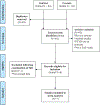GxE effects of FKBP5 and traumatic life events on PTSD: A meta-analysis
- PMID: 30273884
- PMCID: PMC6487483
- DOI: 10.1016/j.jad.2018.09.058
GxE effects of FKBP5 and traumatic life events on PTSD: A meta-analysis
Abstract
Background: Twin studies have demonstrated that both genetic and environmental factors influence risk for posttraumatic stress disorder (PTSD), and there is some evidence supporting the interplay of genes and environment (GxE). Many GxE studies within the PTSD literature have focused on genes implicated in the stress response system, such as FK506 binding protein 51 (FKBP5). Given inconsistencies across GxE literature as a whole, a meta-analysis to synthesize results is warranted.
Methods: Studies were identified through PubMed and PsycINFO. A meta-analysis was conducted using a random effects model in the MAc package in R. Heterogeneity of the effect size distribution was examined with Cochran's Q statistic. A Simes procedure was used to test the gene-level GxE effect for FKBP5 interacting with trauma.
Results: A significant gene-level GxE gene effect was demonstrated for FKBP5 when pooled across all four examined variants (rs1360780, rs3800373, rs9296158, rs9470080) when interacting with trauma exposure on PTSD. Significant large GxE effect sizes were also found for each independent variant. There was no evidence for heterogeneity of variance.
Limitations: Limitations include reduced power for detecting variability across moderators, potential bias due to failure of meta-analyzed studies to account for two-way covariate x gene and covariate x environment influences, and a high false discovery rate that is characteristic of GxE analyses.
Conclusions: This is the first study to quantify an overall gene-level effect of FKBP5 in a GxE analysis of PTSD, evidence which may be used to address current issues in the FKBP5 GxE literature (e.g., disparate variants, low sample sizes and power), as well as inform follow-up functional research.
Keywords: Alcohol; FKBP5; GxE; Posttraumatic stress; Trauma.
Copyright © 2018. Published by Elsevier B.V.
Conflict of interest statement
Declaration of interest
None of the authors declare any conflict of interest.
Figures
References
-
- Amstadter AB, Aggen SH, Knudsen GP, Reichborn-Kjennerud T, Kendler KS, 2012. A population-based study of familial and individual-specific environmental contributions to traumatic event exposure and posttraumatic stress disorder symptoms in a Norwegian twin sample. Twin Res. Hum. Genet 15 (05), 656–662. - PMC - PubMed
-
- Barrett JC, Fry B, Maller J, Daly MJ, 2004. Haploview: analysis and visualization of LD and haplotype maps. Bioinformatics 21 (2), 263–265. - PubMed
-
- Binder EB, 2009. The role of FKBP5, a co-chaperone of the glucocorticoid receptor in the pathogenesis and therapy of affective and anxiety disorders. Psychoneuroendocrinology 34, S186–S195. - PubMed
-
- Binder EB, Bradley RG, Liu W, Epstein MP, Deveau TC, Mercer KB, Tang Y, Gillespie CF, Heim CM, Nemeroff CB, Schwartz AC, 2008. Association of FKBP5 polymorphisms and childhood abuse with risk of posttraumatic stress disorder symptoms in adults. Jama 299 (11), 1291–1305. 10.1001/jama.299.11.1291. - DOI - PMC - PubMed
Publication types
MeSH terms
Substances
Grants and funding
LinkOut - more resources
Full Text Sources
Medical
Miscellaneous



